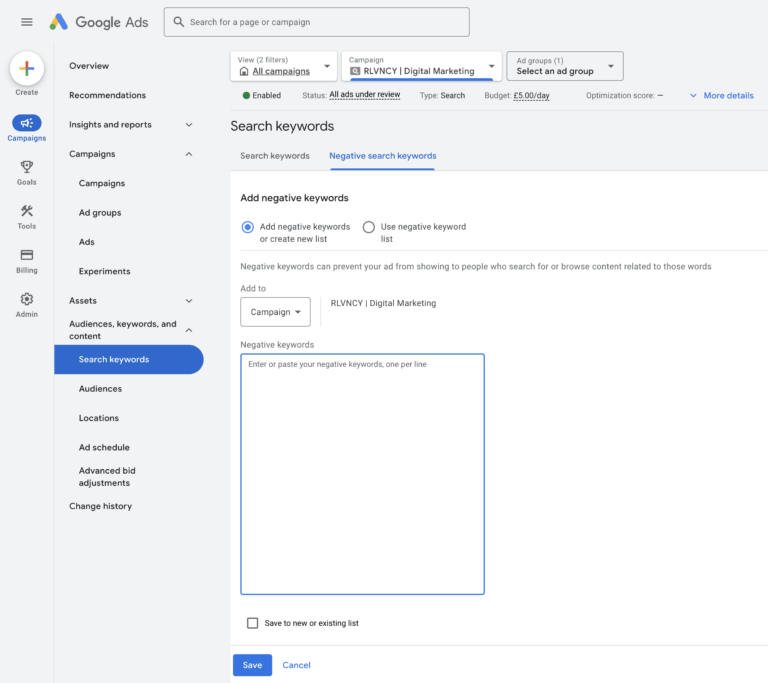
How To Use Negative Keywords In Your PPC Campaigns (Google)
PPC
DIGITAL MARKETING STRATEGY
DATA
What Are Negative Keywords?
Negative keywords allow you to exclude certain search terms from triggering your ads. This ensures that your ad is not shown to people who are unlikely to be interested in your offering, saving your ad budget from being spent on irrelevant clicks. One of the fundamental digital marketing strategies for an efficient PPC setup.
For example, if you sell high-end luxury watches, you wouldn’t want your ads to show up when someone searches for “cheap watches”, “watch repair” or “sports watch.”
By using negative keywords, you:
- Reduce Wasted Spend: Your ads won’t show for searches that are unlikely to convert
- Improve Click-Through Rate (CTR): Your ads will be more relevant to the searcher, so they are more likely to click
- Increase Conversion Rate: By filtering out irrelevant traffic, you focus your budget on users more likely to convert
- Enhance Ad Quality Score: Google and other ad platforms reward high relevancy (RLVNCY), so your Quality Score improves, lowering your cost-per-click (CPC).


How to Implement Negative Keywords in Your PPC Campaigns
1. Identify Negative Keywords
- Review Search Query Reports: Look at the search terms report in Google Ads to see which queries triggered your ads but didn’t lead to conversions. You’ll likely find irrelevant keywords here.
- Brainstorm Potentially Irrelevant Queries: Think about search terms related to your product that don’t align with your target audience. For example, if you offer luxury shoes, terms like “cheap shoes,” “used shoes,” or “shoe repair” might not be relevant.
- Use Negative Keyword Tools: Tools like Google’s Keyword Planner or third-party tools (e.g., SEMrush, Ubersuggest) can help you find irrelevant keyword variants that people search for.
2. Add Negative Keywords
Once you have a list of negative keywords, follow these steps to add them to your campaign:
- Click on “Keywords.”
- At the top of the page, click on the “Negative Keywords” tab
- Click on the “+” button to add new negative keywords
- Choose whether you want to add negative keywords at the Campaign level or Ad Group level:
- Campaign level: The keywords will block queries across the entire campaign
- Ad Group level: The keywords will only block queries for that specific ad group
- Paste or type your negative keywords into the box
- Click “Save.”
3. Monitor and Refine
- Regularly review your search term reports to ensure your negative keywords are working as intended.
- Adjust your list of negative keywords as you discover new irrelevant terms or patterns of search queries that aren’t converting.
Example in Practice
Let’s say you run a PPC campaign for a premium leather shoe company. Your target audience is looking for high-end leather shoes, but you notice in the search query report that your ads are showing up for searches like “cheap leather shoes,” “shoe repair,” and “free shoes.”
This is wasted ad spend. To stop this, you can add “cheap,” “free,” “repair,” “used” as negative keywords.
Here’s how this would look in practice:
- Campaign: “Premium Leather Shoes”
- Search Terms Triggering Ads: “Cheap leather shoes,” “free leather shoes,” “leather shoe repair.”
- Add Negative Keywords: Add “cheap,” “free,” “repair” to the negative keyword list.
- Result: Now, your ad will not show when someone searches “cheap leather shoes” or “leather shoe repair,” allowing you to focus your budget on people genuinely interested in buying premium leather shoes.
Types of Negative Keywords
- Exact Match: Your ad won’t show for the exact search query. For example, if “cheap leather shoes” is an exact-match negative keyword, your ad will not show for this search term.
- Phrase Match: Your ad won’t show if the query contains the phrase. For example, if “cheap shoes” is a phrase-match negative keyword, your ad won’t show for “buy cheap leather shoes.”
- Broad Match: Your ad won’t show if any part of the search term contains the keyword. For example, if “cheap” is a broad-match negative keyword, your ad won’t show for any search containing the word “cheap,” like “cheap men’s leather shoes.”
Key Takeaways
- Use negative keywords to eliminate irrelevant traffic and prevent wasting ad spend.
- Regularly review search term reports to identify which queries are bringing in irrelevant traffic.
- Be strategic in how you apply negative keywords (campaign vs. ad group level).
- Monitor performance and continuously refine your negative keyword list to maintain efficiency in your PPC campaigns.
This approach will help ensure your PPC campaigns are tightly focused, leading to higher-quality traffic, better performance, and a more efficient use of your advertising budget.